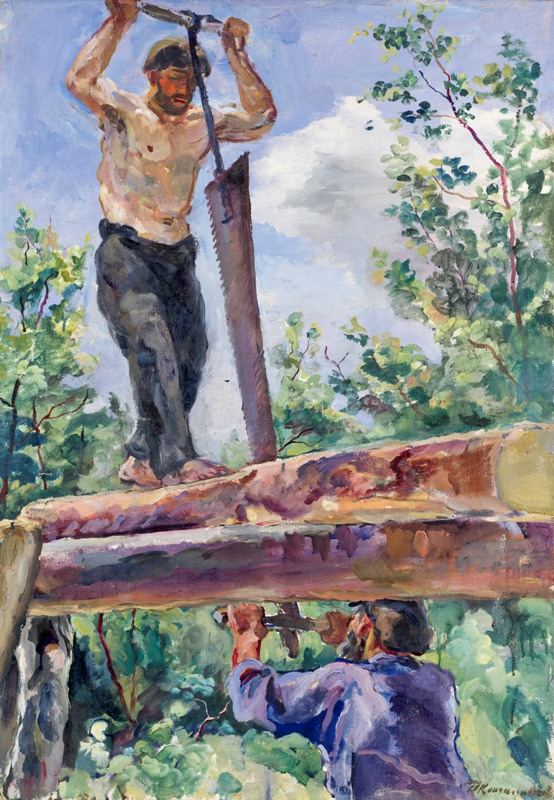5 June 2019 Important Russian Art Auctions, at Asia House
5 June 2019

32. KONCHALOVSKY, PETR (1876–1956)
Woodcutters, signed, also further signed, numbered "1030" and dated 1932 on the reverse.
Oil on canvas, 101.5 by 71 cm.
100,000–200,000 GBP
Provenance: Private collection, Europe.
Exhibited: Vystavka kartin zasluzhennogo deiatelia iskusstv P.P. Konchalovskogo. 1930–1932, Vsekokhudozhnik, Moscow, January 1932.
Literature: Exhibition catalogue, Vystavka kartin zasluzhennogo deiatelia iskusstv P.P. Konchalovskogo. 1930–1932, Moscow, Vsekokhudozhnik, 1932, listed.
Possibly, V. Nikolskii, Petr Petrovich Konchalovsky, Moscow, Vsekokhudozhnik, 1936, p. 123, mentioned in the text.
Konchalovsky. Khudozhestvennoe nasledie, Moscow, Iskusstvo, 1964, p. 130, listed as “zhi 835”.
Exhibition catalogue, N. Avtonomova, A. Lukanova (eds), Unknown Konchalovsky, Moscow, Axiom Graphic, 2002, p. 129, the present work can be seen in the photograph of the artist’s 1932 solo exhibition display.
Woodcutters, the dynamic, full of joie de vivre picture was painted by Petr Konchalovsky in the early 1930s, during one of the most productive periods in his work — at the time of his fascination with real-life subjects and ordinary human types. The poetry of the life around him particularly captivated Konchalovsky after the purchase in 1932 of a dacha in Bugry. The artist’s parents once had an estate that they had lost before the revolution, and he was now trying to recreate the old manorial way of life through the subjects of his works, if not in reality. He spent the whole summer of 1932 with his family at the dacha, mainly working on landscapes. Konchalovsky was especially fascinated by painting “against the light” and the effects of portraying silver flecks of sunlight on grass and leaves.
According to the artist’s biographer Viktor Nikolskii, who was staying at Bugry at that time, “...the summer of 1932 was a splendid one, and Konchalovsky had such an unstoppable surge of creativity, that new canvasses appeared continuously, one after the other. There were landscapes, bunches of flowers and flowering gardens, all kinds of still lifes, sketches of the female body amid a landscape and even the genre sketch Woodcutters. Never before, it seemed, had the master worked with such unremitting enthusiasm, such élan and such speed” (V. Nikolskii, Petr Petrovich Konchalovsky, Moscow, Vsekokhudozhnik, 1936, p. 123).
Konchalovsky devoted his leisure time after the plein air sessions to hunting, reading and, most importantly, to small domestic chores, on which he was very keen. It was even a matter of pride to the artist that he invented a special device for sawing wood, since he had a particular love of carpentry. The choice for his composition of an everyday subject that was close to him allowed Konchalovsky to showcase his considerable skills in genre art, skills that allowed him to juxtapose the expertly portrayed dynamic models and an evocative, expressive sunlit landscape.
The painting Woodcutters is especially appealing because of its seemingly uncontrived and inadvertent composition, which retains all the freshness of a first impression. Everything that is secondary has been discarded. The main focus is on the dynamics of the intersection of the horizontal line formed by the huge logs, which appear to divide the picture into two levels, and the sharp diagonal line of the saw that is held by the busy workmen.
Konchalovsky conveys with particular expressiveness the light that is pouring down from the sky in an even, silvery stream. Without it, the restrained palette of the emerald, bluish-grey and ochre tones in the background would be dull and monotonous, but the flashes of gleaming light and patches of colour that are dispersed over the naked torso and the freshly smoothed tree bark make all the colours resonate with a particular intensity, sonority and richness. The picture is painted by a free-flowing, confident hand and with a broad, thick, artistic brushstroke, yet the well-thought-out compositional completeness that marks the artist’s works of this period can be sensed throughout the scene.
Konchalovsky manages to create a remarkable artistic method in which the harmony of movement and repose, of the fleeting and the steady gives rise to an optimistic image of everyday life and prompts the viewer to admire the beauty of mundane events, which was a typical feature of Konchalovsky’s paintings, and which made the Soviet critics of the 1930s so uneasy.
Notes on symbols:
* Indicates 5% Import Duty Charge applies.
Ω Indicates 20% Import Duty Charge applies.
§ Indicates Artist's Resale Right applies.
† Indicates Standard VAT scheme applies, and the rate of 20% VAT will be charged on both hammer price and premium.